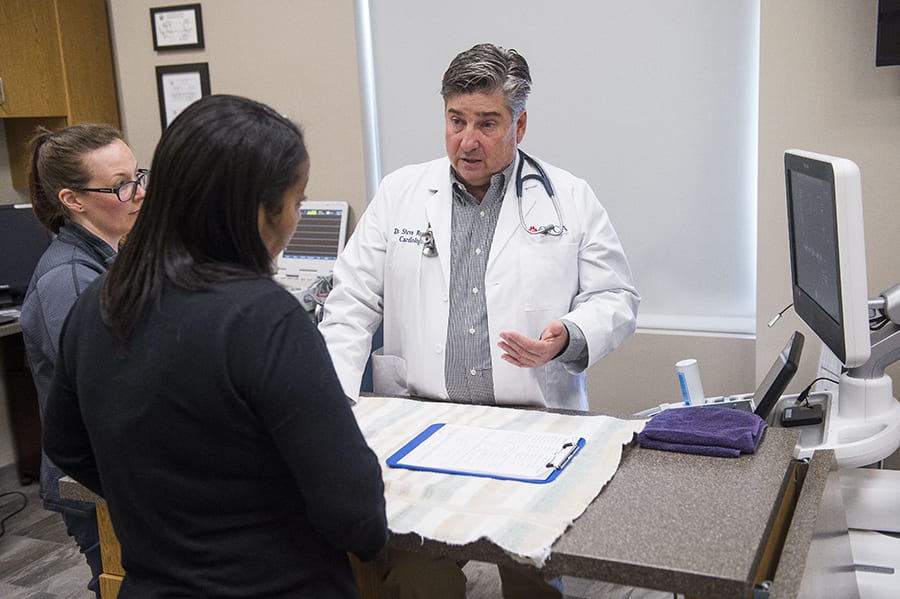Why CT Scans For Animals Are Becoming Standard in Modern Veterinary Medicine}
Wiki Article
The Function of Ultrasound and CT Check in Modern Veterinary Practices: Insights From Experienced Professionals
In modern veterinary techniques, ultrasound and CT scans considerably boost diagnostic capabilities. These imaging methods give essential understandings into animal health and wellness, directing therapy choices. Experienced experts identify the distinct benefits of each method. Ultrasound offers real-time assessments, while CT checks deliver intricate anatomical information. Recognizing their roles and applications raises important questions concerning their influence on client outcomes and the future of vet diagnostics. What understandings can be gotten from their integrated usage?Comprehending Ultrasound in Veterinary Medication
Ultrasound is a necessary analysis device in vet medicine, using a non-invasive method to imagine internal frameworks. This imaging strategy employs high-frequency audio waves to develop real-time photos of tissues and organs, allowing vets to assess problems without medical treatment. Typical applications include examining the heart, liver, kidneys, and reproductive organs, in addition to keeping an eye on pregnancies.The procedure is relatively fast and can be executed in different settings, making it an available option for vets. Unlike radiography, ultrasound gives in-depth info about soft cells and blood circulation, which is important for accurate diagnoses.Veterinary specialists count on ultrasound to discover irregularities such as tumors, cysts, and liquid build-up. Its ability to lead biopsies and various other procedures further enhances its utility in clinical technique. By using a efficient and safe means to analyze internal composition, ultrasound has come to be a foundation of modern vet diagnostics.
The Advantages of CT Scans for Pet Diagnostics
CT scans deal considerable advantages in veterinary diagnostics by supplying enhanced accuracy in recognizing internal problems (CT Scans For Animals). As a non-invasive imaging strategy, they guarantee the security and convenience of animals throughout exams. In enhancement, CT checks facilitate an extensive assessment of interior frameworks, permitting a lot more efficient treatment planningImproved Analysis Accuracy
Advancements in imaging technology have actually considerably boosted analysis precision in veterinary medication, particularly via making use of CT scans. These scans supply thorough cross-sectional pictures of an animal's internal structures, enabling veterinarians to identify abnormalities with precision. The high resolution and three-dimensional capacities of CT imaging facilitate the detection of problems such as lumps, fractures, and interior blood loss that might be missed out on with conventional imaging methods. Furthermore, CT scans can help in pre-surgical preparation by providing a detailed sight of anatomical connections. This level of information not just improves the accuracy of diagnoses yet likewise help in customizing effective treatment strategies. Consequently, the assimilation of CT innovation right into veterinary methods is transforming the landscape of animal health care, enhancing results for clients.Non-Invasive Imaging Method
The introduction of non-invasive imaging methods has transformed pet diagnostics, with CT scans arising as a popular device in vet methods. These scans give high-resolution, cross-sectional photos of a pet's internal structures, allowing veterinarians to analyze intricate problems without the need for intrusive treatments. The advantages of CT scans include their capacity to discover tumors, fractures, and internal blood loss with remarkable accuracy. Additionally, they help with the evaluation of soft tissues and body organs, enhancing diagnostic capacities. The rate of CT scanning enables fast decision-making, which is vital in emergency situation situations. By reducing stress and anxiety and discomfort for the animal, CT scans add to an extra gentle strategy to diagnostics, inevitably enhancing treatment end results and progressing veterinary treatment.Comprehensive Internal Assessment
A complete inner evaluation is vital for precise diagnosis and effective therapy in veterinary medication. CT scans offer substantial advantages in this regard, offering detailed cross-sectional photos of a pet's interior structures. This advanced imaging technique enhances visualization of complicated anatomical regions, making it possible for vets to identify abnormalities such as tumors, fractures, and inner blood loss with higher precision. On top of that, CT checks help with the evaluation of problems that may be challenging to detect with typical techniques. The speed and accuracy of CT imaging likewise add to prompt treatments, improving patient outcomes. As vet techniques progressively incorporate CT innovation, the advantages of considerable interior analyses end up being noticeable, enhancing the importance of this device in modern veterinary diagnostics.Comparing Ultrasound and CT Imaging Techniques
While both ultrasound and CT imaging serve vital functions in veterinary diagnostics, each technique supplies distinctive advantages and limitations that can influence scientific decision-making. Ultrasound is specifically valued for its real-time imaging capabilities, enabling veterinarians to observe dynamic physiological procedures. This strategy is non-invasive, mobile, and does not entail ionizing radiation, making it a safer choice for both clinicians and animals. However, ultrasound might have constraints in imagining specific anatomical structures or deep tissues.Conversely, CT imaging provides detailed cross-sectional sights of the body, enabling for accurate localization of problems. It excels in assessing complicated body organs and structures, particularly in the thorax and abdomen. CT scans call for sedation or anesthesia in numerous situations and entail exposure to ionizing radiation. Ultimately, the selection in between ultrasound and CT relies on the particular professional circumstance, the area of passion, and the necessity of the diagnostic demands.Situation Studies: Effective Diagnoses Via Imaging
Study show the substantial enhancements in analysis precision attained via sophisticated imaging modern technologies like ultrasound and CT scans in veterinary techniques. These innovations not only improve the discovery of numerous conditions but also facilitate timely and effective treatment plans. Examining specific instances can highlight the transformative impact of these imaging strategies on vet medicine.Diagnostic Accuracy Improvements

Imaging Technology Advancements
Look At ThisAs vet imaging innovation continues to evolve, its impact on analysis capacities becomes significantly apparent. Recent study highlight the successful application of innovative ultrasound and CT check methods in recognizing intricate conditions. A veterinary center utilized high-resolution CT scans to diagnose a rare form of lung cancer cells in a dog, which standard imaging had actually missed. An ultrasound exam exposed an abdominal mass in a feline, prompting timely medical intervention and a positive result. These improvements not just improve diagnostic accuracy but likewise enable veterinarians to devise targeted therapy plans. By leveraging advanced imaging technologies, veterinary specialists are considerably improving individual care, resulting in a lot more efficient management of numerous health conditions in animals.
The Function of Imaging in Emergency Veterinary Care
Imaging plays a necessary function in emergency vet treatment, supplying veterinarians with vital details required to make quick, enlightened decisions. In immediate circumstances, strategies like ultrasound and CT scans allow experts to rapidly examine a pet's internal structures, determining crucial conditions such as interior bleeding, cracks, or body organ abnormalities. These imaging modalities enable real-time analyses, promoting timely interventions that can be life-saving. Ultrasound is vital for assessing soft cells injuries and problems like liquid accumulation, while CT scans deal thorough photos of complicated anatomical structures, essential for diagnosing trauma situations. The rate and precision of these imaging methods improve the veterinarian's capability to devise effective therapy strategies, making sure the ideal feasible end results for their patients. Consequently, the assimilation of advanced imaging technologies into emergency veterinary methods is not just advantageous but significantly necessary, as it enhances diagnostic capabilities and enhances total pet care during defining moments.Training and Expertise in Vet Imaging
Innovative imaging techniques such as ultrasound and CT scans are important for effective vet care, the effective application of these modern technologies heavily depends on the training and knowledge of vet specialists. Efficient use imaging devices calls for thorough knowledge of makeup, pathology, and the useful source principles underlying each modality. Veterinary professionals must undertake specialized training to accurately analyze imaging outcomes, which is vital for diagnosing conditions and planning treatment.Certifications and proceeding education in veterinary imaging enhance the abilities of practitioners, enabling them to stay updated with technological developments. Collaboration in between radiologists and veterinarians commonly leads to enhanced analysis precision, as specialists can give insights into complex situations. Furthermore, useful experience in dealing with imaging equipment promotes self-confidence in its application. Ultimately, the top quality of vet imaging services is directly associated to the degree of training and know-how possessed by the experts making use of these important diagnostic tools.Future Trends in Diagnostic Imaging for Animals
With the fast innovations in innovation, veterinary diagnostic imaging is positioned for significant development in the coming years. Emerging trends show a shift in the direction of even more easily accessible and mobile imaging modalities, such as handheld ultrasound devices, which can enhance area diagnostics. Furthermore, the combination of fabricated knowledge is anticipated to transform picture evaluation, allowing for quicker and extra accurate analyses of results.Moreover, developments in 3D imaging methods and computed tomography will certainly offer veterinarians with more detailed sights of pet anatomy, causing improved treatment plans. Virtual reality innovation may additionally play a duty in medical preparation and education, giving veterinarians an one-of-a-kind perspective on intricate cases.As telemedicine continues to expand, go to website remote appointments assisted in by diagnostic imaging will come to be more typical, enabling specialists to aid family doctors in real-time. Generally, these patterns are readied to enhance the effectiveness and effectiveness of veterinary care, eventually enhancing animal results.Frequently Asked Concerns
How Much Do Ultrasound and CT Scans Expense in Veterinary Clinics?
The prices of ultrasound and CT scans in vet centers typically range from $300 to $1,500, depending upon aspects such as location, center type, and certain procedures required for the animal's diagnosis and therapy.
Are There Any Type Of Dangers Connected With Ultrasound and CT Checks for Family Pets?
Ultrasound and CT scans normally posture minimal risks to family pets. However, possible worries include sedation reactions and exposure to anesthetics. Ultrasound For Dogs. Veterinarians thoroughly assess each situation to reduce any type of dangers connected with these diagnostic treatmentsJust How Long Do Ultrasound and CT Treatments Usually Take?
Ultrasound treatments normally take around half an hour to an hour, depending on the intricacy. CT scans, being even more in-depth, typically call for 30 mins to 90 mins, consisting of prep work and healing time for the pet.Can All Veterinarians Perform Ultrasounds and CT Scans?
Not all vets can perform ultrasounds and CT scans. Specialized training and qualification are commonly called for to assure proficiency in these sophisticated imaging techniques, which may restrict their schedule to veterinarians with additional credentials and sources.What Kinds Of Pets Profit Many From These Imaging Techniques?
Particular pet species, specifically felines and dogs, advantage considerably from ultrasound and CT scans. These imaging strategies boost diagnostic precision for problems like growths, interior injuries, and body organ abnormalities, leading to improved therapy outcomes and patient care. The high resolution and three-dimensional capabilities of CT imaging help with the detection of problems such as tumors, fractures, and interior blood loss that may be missed out on with standard imaging techniques. Situation researches show the substantial renovations in analysis accuracy achieved via sophisticated imaging technologies like ultrasound and CT scans in veterinary techniques. Improving diagnostic precision in veterinary techniques has been substantially helped by innovations in imaging innovations such as ultrasound and CT scans. Sophisticated imaging strategies such as ultrasound and CT scans are essential for effective veterinary care, the successful application of these modern technologies greatly depends on the training and expertise of vet professionals. Veterinary experts must go through specialized training to accurately analyze imaging outcomes, which is crucial for diagnosing conditions and planning treatment.Certifications and continuing education and learning in veterinary imaging enhance the skills of experts, allowing them to stay updated with technical improvements.Report this wiki page